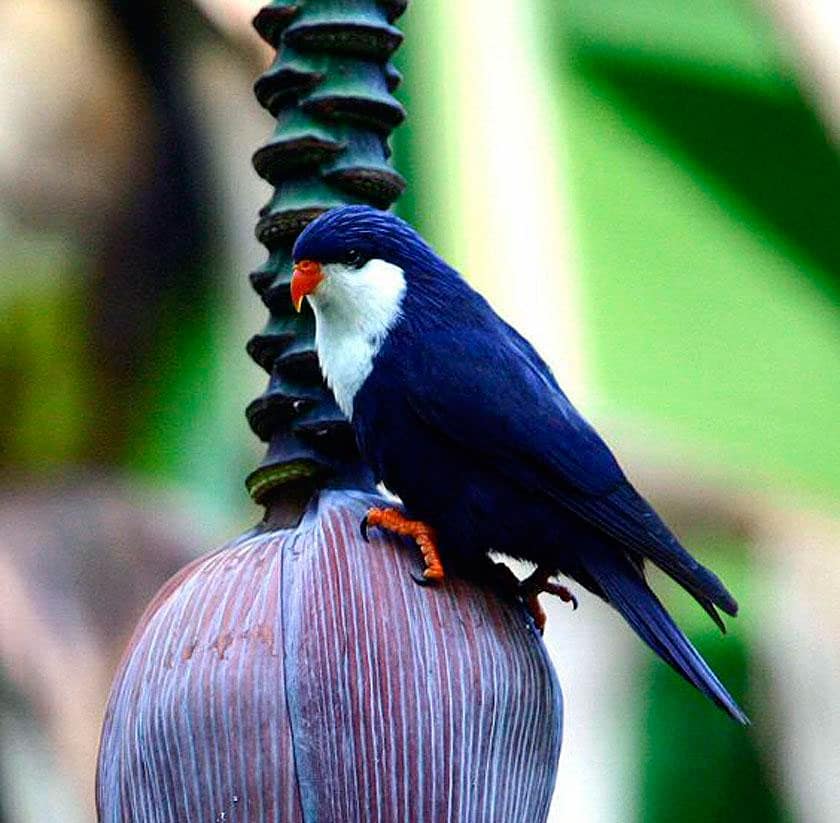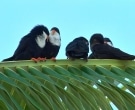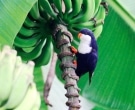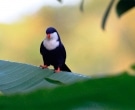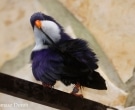Content |
|---|
Description
The Blue Lorikeet (Vini peruviana) has an approximate length of 18 cm.. and a weight ranging between 31 and 34 g..
Dark blue bright in the crown with paler veins; The feathers of the back of the crown, elongated as in other members of the genus; Lords and ear-coverts white. Upperparts dark blue bright with Plumas-bases blackish. Upper wing bright blue with the internals of the flight feather brownish colour. Underwing coverts dark blue, the rest of Underwing color negro.
Throat and upper breast white; bright dark blue rest, underparts on the basis of blackish feathers. The tail dark blue, with the slightly elongated central feathers typical of the genus; undertail blackish.
The bill orange; Iris yellowish brown; Legs orange color.
Male slightly larger, particularly the head and the bill, with the chin pure white. Legs they can also be a bit darker.
The immature differs from the adult as having the underparts uniform greyish-black, with the exception of some small white spots on the chin. Black the bill. Dark brown the irises and legs dark brown.
- Sound of the Blue Lorikeet.
Habitat:
It depends largely on coconut palm (Cocoa nuts) for food and nesting, Although other species such as the banana and Hibiscus they are also frequented by the Blue Lorikeet.
Sometimes they look around the villages and in the gardens. The Blue Lorikeet they are very active, rarely remain long in one place. They are usually seen in small groups of a maximum of seven birds that fly between the coconut trees in flower.
Reproduction:
The breeding It is estimated that it is from May to July. Nests in the coconut trees, either in a hollow log or in a rotten coconut palm still attached to the tree, also have seen them are nesting in a stump of Pandanus fallen. The laying is two eggs that incubate for 25 days and the fledgling young leaves the nest in 6-8 weeks.
Food:
They feed on nectar, but foraging on the ground and the search for small insects on the underside of the leaves have also been recorded..
Distribution:
The Blue Lorikeet It was formerly widespread in the The Society Islands and the Tuatnotu archipelago, but at present is absent from 15 of the 23 Islands where dwelt in the past (some of which can be to come back to enter), including tahiti, Bora-Bora and Moorea, the largest group of the Society Islands (c expiry date. 1900 of tahiti and Moorea; decade of 1920 for Bora-Bora).
Although the population decline has been linked to a series of threats, including the introduction of the the swamp Harrier (Cirrus approximans) and introduction of a malaria avian provoked by the Culicoides mosquito; predation by rats and cats is the most serious problem facing the species. The distribution currently in the different islands, including population estimated with the dates when they know, shown below (but there are several more islands that have never been visited and that could still be suitable to support the species).
– The Society Islands: Motu One 250 couples; Manuae 300-400 couples in 1974 but in apparent decline following the introduction of cats in 1975.
– Tuamotu archipelago: Tikehau 30 couples in 1984; Rangiroa 100-200 birds before 1972, were kept in 1991 but the numbers are not quantified; Arutua, apparently they were still present 1975 but no current stats; Manihi a bird in 1991; Kaukura last sighting in 1923; No estimate of population; Apataki 1989 survey gave a minimum of 300 birds.
– Islas Cook: Aitutaki probably introduced; until 500 couples present in 1991; Island Hervey possibly introduced in the past, but there is no recent information.
– The population in Aitutaki seems stable and as the Black Rat (Ratuus ruttus) is not present, This island is thought to be the hope for the survival of the species.
Conservation:
– Current IUCN Red List category: Vulnerable
– The population trend: Decreasing
There are few data on population trends; But, the species has declined gradually in each island, where cats, the black rats of Marsh Harriers have colonized the coast. So, a slow to moderate fall in the population is suspicious.
The threat of extinction of this species in the Islands, It is more than likely due to their predation by black rats (Rattus rattus) and to a lesser extent, by the Feral cats (Felis catus). Their extinction since Makatea in the Tuamotu archipelago could have been accelerated by a particularly violent hurricane. Its reduction in the scope of the Society Islands correlated with the spread of the marsh harriers (Circus approximans) introduced. The accidental introduction of black rats on islands where the Blue Lorikeet It is a continuous threat to the species.
"Blue Lorikeet" in captivity:
There are more than 20 males in captivity, but only about ten females. The species was first raised in captivity in 1937 by Lord Tavistock, but until 1977, When a group of birds seized in the U.S.. He was sent to the poultry farmer Rosemary Low en el Reino Unido, These birds were practically unknown in poultry.
Also have grown up in the San Diego Zoo, whose success with breeding two females in 1979 He had much international publicity when parents, that had been confiscated from smugglers, escaped destruction by customs officers after a public outcry.
Alternative names:
– Blue Lorikeet, Pacific Lorikeet, Tahiti Lorikeet, Tahiti Lory, Tahitian Lorikeet, Tahitian Lory, Thaitian lory, Violet Lorikeet (ingles).
– Lori nonnette, Lori de Tahiti, Perruche nonnette (French).
– Saphirlori (German).
– Loris Vini Peruviana (Portuguese).
– Lori Monjita, Lorito Zafiro (español).
scientific classification:
– Order: Psittaciformes
– Family: Psittaculidae
– Genus: Vini
– Scientific name: Vini peruviana
– Citation: (Statius Müller, 1776)
– Protonimo: Psittacus peruvianus
Images “Blue Lorikeet”:
Video “Blue Lorikeet”:
————————————————————————————————
“Blue Lorikeet” (Vini peruviana)
Sources:
– Avibase
– Parrots of the World – Forshaw Joseph M
– Parrots A Guide to the Parrots of the World – Tony Juniper & Mike Parr
– Birdlife
– Photos:
1 – free-pet-wallpapers
2 – Two adults (left) close to a three immature birds perched in a palm tree. – Author Josep del Hoyo – lynxeds
3 – Miles to the wild – Enlace
4 – Miles to the wild – Enlace
5 – Adult bird preening. Author Tomasz Doron – lynxeds
– Sounds: Matthias Feuersenger (Xeno-canto)
